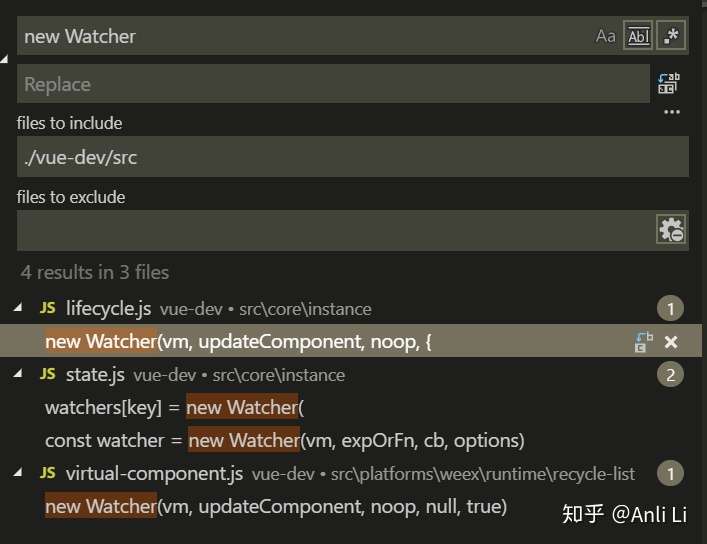本文共 11373 字,大约阅读时间需要 37 分钟。
Vue源码阅读连载之响应式设计
书接上回,谈到Vue是在Vue.prototype._init里调用了initState初始化了响应式的组成,看一下initState的源码
export function initState (vm: Component) { vm._watchers = [] const opts = vm.$options if (opts.props) initProps(vm, opts.props) if (opts.methods) initMethods(vm, opts.methods) if (opts.data) { initData(vm) } else { observe(vm._data = {}, true /* asRootData */) } if (opts.computed) initComputed(vm, opts.computed) if (opts.watch && opts.watch !== nativeWatch) { initWatch(vm, opts.watch) }} 这里面除了methods,其它像props、data之类的都是响应式的,如果在模板里面引用到了其中某个变量,在变量发生变化的时候会主动通知进而更新DOM。
Object.defineProperty
只要读过官网文档就都知道Vue里响应式设计的基本原理就是这个方法,这个方法在es5里被引入,属于元编程,就是说在之前版本的JavaScript里无法使用既有的语法来对它进行模拟,这也就是Vue无法支持IE9以下的浏览器的原因。
但是Object.defineProperty也有它的缺陷,一些变化还是追踪不到的,比如在对象上新增一个值,delete一个值,以及数组上针对索引直接赋值等,Vue对此提供了$set和$delete方法来补充,后面会讲到。
要真正弥补缺陷,还是要依靠es6的Proxy,但它也是属于元编程。即便是Babel目前也对它无能为力。

所以要等到完美实现自动挡的响应式,还是要让es6得到浏览器的全面支持才行。

看一下Object.defineProperty的用法
Object.defineProperties(obj, props)
其中props可以配置get和set,这样就有了一个切入点能让我来干点什么。
var obj = {};Object.defineProperty(obj, "data", { get: function() { //把依赖收集起来 }, set: function() { //通知依赖要更新了 }}) 所以可以抽象出一个依赖的对象来,叫Dep,此时可以把Object.defineProperty重新封装一下,在/src/core/observer/index.js里
export function defineReactive ( obj: Object, key: string, val: any, customSetter?: ?Function, shallow?: boolean) { const dep = new Dep() const property = Object.getOwnPropertyDescriptor(obj, key) if (property && property.configurable === false) { return } // cater for pre-defined getter/setters const getter = property && property.get const setter = property && property.set if ((!getter || setter) && arguments.length === 2) { val = obj[key] } let childOb = !shallow && observe(val) Object.defineProperty(obj, key, { enumerable: true, configurable: true, get: function reactiveGetter () { const value = getter ? getter.call(obj) : val if (Dep.target) { dep.depend() if (childOb) { childOb.dep.depend() if (Array.isArray(value)) { dependArray(value) } } } return value }, set: function reactiveSetter (newVal) { const value = getter ? getter.call(obj) : val /* eslint-disable no-self-compare */ if (newVal === value || (newVal !== newVal && value !== value)) { return } // #7981: for accessor properties without setter if (getter && !setter) return if (setter) { setter.call(obj, newVal) } else { val = newVal } childOb = !shallow && observe(newVal) dep.notify() } })} 这个方法里有一个Dep对象,在get的时候就更新这个Dep对象实例维护的依赖数组,在set的时候就通知Dep对象里的依赖数组去执行更新。
这里看不懂没关系,一直往下走,走到框图那里就好了,到时候记得再回来看代码。

Dep和Watcher
Dep对象的定义在/src/core/observer/dep.js
/* @flow */import type Watcher from './watcher'import { remove } from '../util/index'import config from '../config'let uid = 0/** * A dep is an observable that can have multiple * directives subscribing to it. */export default class Dep { static target: ?Watcher; id: number; subs: Array ; constructor () { this.id = uid++ this.subs = [] } addSub (sub: Watcher) { this.subs.push(sub) } removeSub (sub: Watcher) { remove(this.subs, sub) } depend () { if (Dep.target) { Dep.target.addDep(this) } } notify () { // stabilize the subscriber list first const subs = this.subs.slice() if (process.env.NODE_ENV !== 'production' && !config.async) { // subs aren't sorted in scheduler if not running async // we need to sort them now to make sure they fire in correct // order subs.sort((a, b) => a.id - b.id) } for (let i = 0, l = subs.length; i < l; i++) { subs[i].update() } }}// The current target watcher being evaluated.// This is globally unique because only one watcher// can be evaluated at a time.Dep.target = nullconst targetStack = []export function pushTarget (target: ?Watcher) { targetStack.push(target) Dep.target = target}export function popTarget () { targetStack.pop() Dep.target = targetStack[targetStack.length - 1]} 这里先记住结论,Dep就是一个中间商。Dep实例里面还有一个叫Watcher的对象。这个Watcher对象的定义在/src/core/observer/watcher.js里
let uid = 0export default class Watcher { vm: Component; expression: string; cb: Function; id: number; deep: boolean; user: boolean; lazy: boolean; sync: boolean; dirty: boolean; active: boolean; deps: Array ; newDeps: Array ; depIds: SimpleSet; newDepIds: SimpleSet; before: ?Function; getter: Function; value: any; constructor ( vm: Component, expOrFn: string | Function, cb: Function, options?: ?Object, isRenderWatcher?: boolean ) { this.vm = vm if (isRenderWatcher) { vm._watcher = this } vm._watchers.push(this) // options if (options) { this.deep = !!options.deep this.user = !!options.user this.lazy = !!options.lazy this.sync = !!options.sync this.before = options.before } else { this.deep = this.user = this.lazy = this.sync = false } this.cb = cb this.id = ++uid // uid for batching this.active = true this.dirty = this.lazy // for lazy watchers this.deps = [] this.newDeps = [] this.depIds = new Set() this.newDepIds = new Set() this.expression = process.env.NODE_ENV !== 'production' ? expOrFn.toString() : '' // parse expression for getter if (typeof expOrFn === 'function') { this.getter = expOrFn } else { this.getter = parsePath(expOrFn) if (!this.getter) { this.getter = noop process.env.NODE_ENV !== 'production' && warn( `Failed watching path: "${expOrFn}" ` + 'Watcher only accepts simple dot-delimited paths. ' + 'For full control, use a function instead.', vm ) } } this.value = this.lazy ? undefined : this.get() } /** * Evaluate the getter, and re-collect dependencies. */ get () { pushTarget(this) let value const vm = this.vm try { value = this.getter.call(vm, vm) } catch (e) { if (this.user) { handleError(e, vm, `getter for watcher "${this.expression}"`) } else { throw e } } finally { // "touch" every property so they are all tracked as // dependencies for deep watching if (this.deep) { traverse(value) } popTarget() this.cleanupDeps() } return value } /** * Add a dependency to this directive. */ addDep (dep: Dep) { const id = dep.id if (!this.newDepIds.has(id)) { this.newDepIds.add(id) this.newDeps.push(dep) if (!this.depIds.has(id)) { dep.addSub(this) } } } /** * Clean up for dependency collection. */ cleanupDeps () { let i = this.deps.length while (i--) { const dep = this.deps[i] if (!this.newDepIds.has(dep.id)) { dep.removeSub(this) } } let tmp = this.depIds this.depIds = this.newDepIds this.newDepIds = tmp this.newDepIds.clear() tmp = this.deps this.deps = this.newDeps this.newDeps = tmp this.newDeps.length = 0 } /** * Subscriber interface. * Will be called when a dependency changes. */ update () { /* istanbul ignore else */ if (this.lazy) { this.dirty = true } else if (this.sync) { this.run() } else { queueWatcher(this) } } /** * Scheduler job interface. * Will be called by the scheduler. */ run () { if (this.active) { const value = this.get() if ( value !== this.value || // Deep watchers and watchers on Object/Arrays should fire even // when the value is the same, because the value may // have mutated. isObject(value) || this.deep ) { // set new value const oldValue = this.value this.value = value if (this.user) { try { this.cb.call(this.vm, value, oldValue) } catch (e) { handleError(e, this.vm, `callback for watcher "${this.expression}"`) } } else { this.cb.call(this.vm, value, oldValue) } } } } /** * Evaluate the value of the watcher. * This only gets called for lazy watchers. */ evaluate () { this.value = this.get() this.dirty = false } /** * Depend on all deps collected by this watcher. */ depend () { let i = this.deps.length while (i--) { this.deps[i].depend() } } /** * Remove self from all dependencies' subscriber list. */ teardown () { if (this.active) { // remove self from vm's watcher list // this is a somewhat expensive operation so we skip it // if the vm is being destroyed. if (!this.vm._isBeingDestroyed) { remove(this.vm._watchers, this) } let i = this.deps.length while (i--) { this.deps[i].removeSub(this) } this.active = false } }} 代码贴的有点敷衍[流汗]
其实Watcher对象就代表了一个响应式的内容,比如模板的{
{ }}标记,在{ { }}标记里引用到的变量发生变化时更新DOM,或者某一个computed变量,在它引用到的变量发生变化时进行重新计算,如果它也是被{ { }}标记绑在模板上的话进而触发DOM的更新,还有就是在创建Vue时传入显式定义的watch了,它跟computed也是类似的。更正:其实Vue2.0后用了虚拟DOM,所以不会为每一个模板中使用到的变量创建一个Watcher而是整个组件创建一个Watcher,剩下比较的事情就交给虚拟DOM了。
其实可以在源码里全局搜索一下"new Watcher"关键词,总共也就是四处

Watcher对象和Dep对象里都含有一个属性互相指向了对方,Dep里是subs,Watcher里是deps。
流程

重新再捋一下流程,以模板上用到props里的message为例
- 新建Vue时,传入配置,其中props里包含这个message
- 在调用initProps时,在Vue实例上新建一个内部的空对象_props
- 经过defineReactive之后,这个props里的message转为_props其中的一个对象,这个对象还有get和set方法
- 为虚拟DOM的组件新建一个Watcher对象
- 在新建Watcher对象的构造函数里,会去取一下message的值,这样就触发了get
- 在get里把Watcher对象跟Dep对象关联了起来
- 下一次更新props里message的时候就触发了set,从而更新了DOM
再仔细地走一下,
new Vue( ) → Vue.prototype._init( ) → initState( ) 其中
if (opts.props) initProps(vm, opts.props)
就去初始化props,先建出内部_props空对象,然后循环把props里面内容都通过defineReactive包装为 _props的一个属性,这个属性包含了get和set。
function initProps (vm: Component, propsOptions: Object) { const propsData = vm.$options.propsData || {} const props = vm._props = {} // cache prop keys so that future props updates can iterate using Array // instead of dynamic object key enumeration. const keys = vm.$options._propKeys = [] const isRoot = !vm.$parent // root instance props should be converted if (!isRoot) { toggleObserving(false) } for (const key in propsOptions) { keys.push(key) const value = validateProp(key, propsOptions, propsData, vm) defineReactive(props, key, value) if (!(key in vm)) { proxy(vm, `_props`, key) } } toggleObserving(true)} 等到模板解析的时候发现用到了这个message,于是去新建一个Watcher对象,在它的构造函数最后有调用
this.value = this.lazy ? undefined : this.get()
而get( )里就去获得这个值
get () { pushTarget(this) let value const vm = this.vm try { value = this.getter.call(vm, vm) } catch (e) { if (this.user) { handleError(e, vm, `getter for watcher "${this.expression}"`) } else { throw e } } finally { // "touch" every property so they are all tracked as // dependencies for deep watching if (this.deep) { traverse(value) } popTarget() this.cleanupDeps() } return value } 注意一下pushTarget和popTarget两个方法,它是把当前的Watcher对象放入Dep.target上,注意这个是Dep,也就是类,不是Dep的实例,这样保证了唯一性,反正JavaScript里是单线程的。this.getter在构造函数里被声明为
this.getter = parsePath(expOrFn)
也就是针对表达式的解析,比如"data.x.y.z"这种样子的,
value = this.getter.call(vm, vm)
这一句就能获得这个表达式的值,也就相当于访问了data.x.y.z。
既然访问了这个属性,那么就触发了这个属性上的get,从而把Dep和Watcher建立起连接来,等到下一次触发set的时候自然也就能找到这个属性上挂载的所有的Watcher,从而得到更新。
转载地址:http://tnkei.baihongyu.com/